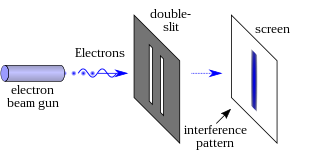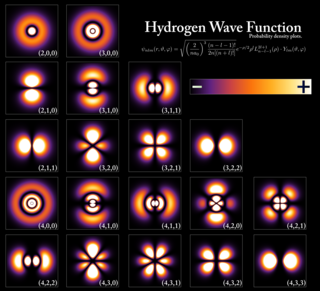
In modern physics, the double-slit experiment demonstrates that light and matter can exhibit behavior of both classical particles and classical waves. This ambiguity is considered evidence for the fundamentally probabilistic nature of quantum mechanics. This type of experiment was first performed by Thomas Young in 1801, as a demonstration of the wave behavior of visible light. In 1927, Davisson and Germer and, independently George Paget Thomson and his research student Alexander Reid demonstrated that electrons show the same behavior, which was later extended to atoms and molecules. Thomas Young's experiment with light was part of classical physics long before the development of quantum mechanics and the concept of wave–particle duality. He believed it demonstrated that the Christiaan Huygens' wave theory of light was correct, and his experiment is sometimes referred to as Young's experiment or Young's slits.

The many-worlds interpretation (MWI) is an interpretation of quantum mechanics that asserts that the universal wavefunction is objectively real, and that there is no wave function collapse. This implies that all possible outcomes of quantum measurements are physically realized in some "world". The evolution of reality as a whole in MWI is rigidly deterministic and local. Many-worlds is also called the relative state formulation or the Everett interpretation, after physicist Hugh Everett, who first proposed it in 1957. Bryce DeWitt popularized the formulation and named it many-worlds in the 1970s.

Quantum mechanics is a fundamental theory that describes the behavior of nature at and below the scale of atoms. It is the foundation of all quantum physics, which includes quantum chemistry, quantum field theory, quantum technology, and quantum information science.
In quantum mechanics, counterfactual definiteness (CFD) is the ability to speak "meaningfully" of the definiteness of the results of measurements that have not been performed. The term "counterfactual definiteness" is used in discussions of physics calculations, especially those related to the phenomenon called quantum entanglement and those related to the Bell inequalities. In such discussions "meaningfully" means the ability to treat these unmeasured results on an equal footing with measured results in statistical calculations. It is this aspect of counterfactual definiteness that is of direct relevance to physics and mathematical models of physical systems and not philosophical concerns regarding the meaning of unmeasured results.
The de Broglie–Bohm theory is an interpretation of quantum mechanics which postulates that, in addition to the wavefunction, an actual configuration of particles exists, even when unobserved. The evolution over time of the configuration of all particles is defined by a guiding equation. The evolution of the wave function over time is given by the Schrödinger equation. The theory is named after Louis de Broglie (1892–1987) and David Bohm (1917–1992).
An interpretation of quantum mechanics is an attempt to explain how the mathematical theory of quantum mechanics might correspond to experienced reality. Quantum mechanics has held up to rigorous and extremely precise tests in an extraordinarily broad range of experiments. However, there exist a number of contending schools of thought over their interpretation. These views on interpretation differ on such fundamental questions as whether quantum mechanics is deterministic or stochastic, local or non-local, which elements of quantum mechanics can be considered real, and what the nature of measurement is, among other matters.
Bell's theorem is a term encompassing a number of closely related results in physics, all of which determine that quantum mechanics is incompatible with local hidden-variable theories, given some basic assumptions about the nature of measurement. "Local" here refers to the principle of locality, the idea that a particle can only be influenced by its immediate surroundings, and that interactions mediated by physical fields cannot propagate faster than the speed of light. "Hidden variables" are supposed properties of quantum particles that are not included in quantum theory but nevertheless affect the outcome of experiments. In the words of physicist John Stewart Bell, for whom this family of results is named, "If [a hidden-variable theory] is local it will not agree with quantum mechanics, and if it agrees with quantum mechanics it will not be local."

John Stewart Bell FRS was a physicist from Northern Ireland and the originator of Bell's theorem, an important theorem in quantum physics regarding hidden-variable theories.
Coherence expresses the potential for two waves to interfere. Two monochromatic beams from a single source always interfere. Wave sources are not strictly monochromatic: they may be partly coherent. Beams from different sources are mutually incoherent.
In physics, the principle of locality states that an object is influenced directly only by its immediate surroundings. A theory that includes the principle of locality is said to be a "local theory". This is an alternative to the concept of instantaneous, or "non-local" action at a distance. Locality evolved out of the field theories of classical physics. The idea is that for a cause at one point to have an effect at another point, something in the space between those points must mediate the action. To exert an influence, something, such as a wave or particle, must travel through the space between the two points, carrying the influence.
The transactional interpretation of quantum mechanics (TIQM) takes the wave function of the standard quantum formalism, and its complex conjugate, to be retarded and advanced waves that form a quantum interaction as a Wheeler–Feynman handshake or transaction. It was first proposed in 1986 by John G. Cramer, who argues that it helps in developing intuition for quantum processes. He also suggests that it avoids the philosophical problems with the Copenhagen interpretation and the role of the observer, and also resolves various quantum paradoxes. TIQM formed a minor plot point in his science fiction novel Einstein's Bridge.

Anton Zeilinger is an Austrian quantum physicist and Nobel laureate in physics of 2022. Zeilinger is professor of physics emeritus at the University of Vienna and senior scientist at the Institute for Quantum Optics and Quantum Information of the Austrian Academy of Sciences. Most of his research concerns the fundamental aspects and applications of quantum entanglement.
The Afshar experiment is a variation of the double-slit experiment in quantum mechanics, devised and carried out by Shahriar Afshar in 2004. In the experiment, light generated by a laser passes through two closely spaced pinholes, and is refocused by a lens so that the image of each pinhole falls on a separate single-photon detector. In addition, a grid of thin wires is placed just before the lens on the dark fringes of an interference pattern.
The Wheeler–Feynman absorber theory, named after its originators, the physicists Richard Feynman and John Archibald Wheeler, is a theory of electrodynamics based on a relativistic correct extension of action at a distance electron particles. The theory postulates no independent electromagnetic field. Rather, the whole theory is encapsulated by the Lorentz-invariant action of particle trajectories defined as
A delayed-choice quantum eraser experiment, first performed by Yoon-Ho Kim, R. Yu, S. P. Kulik, Y. H. Shih and Marlan O. Scully, and reported in early 1998, is an elaboration on the quantum eraser experiment that incorporates concepts considered in John Archibald Wheeler's delayed-choice experiment. The experiment was designed to investigate peculiar consequences of the well-known double-slit experiment in quantum mechanics, as well as the consequences of quantum entanglement.
Retrocausality, or backwards causation, is a concept of cause and effect in which an effect precedes its cause in time and so a later event affects an earlier one. In quantum physics, the distinction between cause and effect is not made at the most fundamental level and so time-symmetric systems can be viewed as causal or retrocausal. Philosophical considerations of time travel often address the same issues as retrocausality, as do treatments of the subject in fiction, but the two phenomena are distinct.
Antony Valentini is a British-Italian theoretical physicist known for his work on the foundations of quantum physics.
Dipankar Home is an Indian theoretical physicist at Bose Institute, Kolkata. He works on the fundamental aspects of quantum mechanics, including quantum entanglement and Quantum communication. He is co-author with Partha Ghose of the popular book Riddles in your Teacup - Fun with Everyday Scientific Puzzles.

Sandu Popescu is a Romanian-British physicist working in the foundations of quantum mechanics and quantum information.






